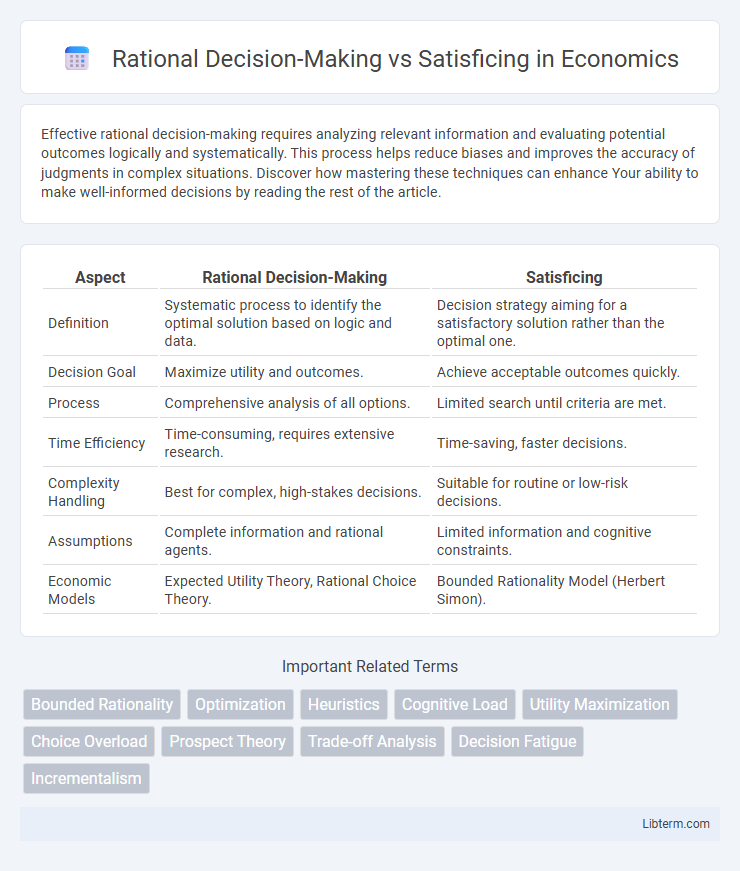Effective rational decision-making requires analyzing relevant information and evaluating potential outcomes logically and systematically. This process helps reduce biases and improves the accuracy of judgments in complex situations. Discover how mastering these techniques can enhance Your ability to make well-informed decisions by reading the rest of the article.
Table of Comparison
| Aspect | Rational Decision-Making | Satisficing |
|---|---|---|
| Definition | Systematic process to identify the optimal solution based on logic and data. | Decision strategy aiming for a satisfactory solution rather than the optimal one. |
| Decision Goal | Maximize utility and outcomes. | Achieve acceptable outcomes quickly. |
| Process | Comprehensive analysis of all options. | Limited search until criteria are met. |
| Time Efficiency | Time-consuming, requires extensive research. | Time-saving, faster decisions. |
| Complexity Handling | Best for complex, high-stakes decisions. | Suitable for routine or low-risk decisions. |
| Assumptions | Complete information and rational agents. | Limited information and cognitive constraints. |
| Economic Models | Expected Utility Theory, Rational Choice Theory. | Bounded Rationality Model (Herbert Simon). |
Understanding Rational Decision-Making
Rational decision-making involves systematically identifying and evaluating all available alternatives to choose the most optimal and logical solution based on clear criteria and thorough analysis. This process requires gathering comprehensive data, weighing pros and cons, predicting outcomes, and minimizing biases to enhance decision quality. Key elements include goal clarity, information completeness, and consistency in applying rational rules throughout the decision process.
Defining Satisficing in Decision Processes
Satisficing in decision processes refers to selecting an option that meets acceptable criteria rather than searching for the optimal solution, balancing efficiency and effectiveness under constraints. This approach acknowledges limited information, time, and cognitive resources, making it particularly valuable in complex or uncertain environments. Unlike rational decision-making, which strives for the best possible outcome, satisficing prioritizes practicality and satisficing thresholds to expedite decisions.
Core Principles of Rational Decision-Making
Rational decision-making centers on systematic analysis, emphasizing identifying objectives, generating alternatives, and evaluating consequences to maximize outcomes. This model relies on logical reasoning, comprehensive information gathering, and consistent preferences to ensure optimal choices. Clear criteria and measurable goals guide the selection process, distinguishing it from satisficing, which prioritizes satisfactory rather than optimal results.
The Origins of Satisficing: Simon’s Theory
Herbert A. Simon introduced satisficing as a realistic alternative to the rational decision-making model, arguing that individuals face cognitive limitations and incomplete information, which prevent them from achieving optimal decisions. Simon's theory emphasizes satisficing as a process where decision-makers seek a solution that is "good enough," balancing aspiration levels against practical constraints. This bounded rationality concept revolutionized economics and behavioral sciences by acknowledging human cognitive limits and environmental complexities in organizational and individual decision-making.
Key Differences Between Rationality and Satisficing
Rational decision-making involves a thorough analysis of all available options to identify the optimal solution based on objective criteria, maximizing utility and minimizing risks. Satisficing, on the other hand, opts for a solution that meets acceptable thresholds or criteria, focusing on efficiency and speed rather than exhaustive optimization. The key difference lies in rationality's exhaustive search for the best outcome, whereas satisficing prioritizes satisfactory choices under constraints like limited time or information.
Benefits and Drawbacks of Rational Decision-Making
Rational decision-making offers benefits such as systematic analysis, clarity in evaluating alternatives, and the potential to maximize outcomes by relying on logical criteria and comprehensive data. However, it can be time-consuming, resource-intensive, and sometimes impractical in situations requiring swift decisions or when information is incomplete. The drawbacks highlight challenges in dynamic environments where strict rationality may hinder adaptability and may lead to analysis paralysis.
Advantages and Challenges of Satisficing
Satisficing offers the advantage of enabling quicker decisions by selecting an option that meets acceptable criteria rather than exhaustive analysis, reducing cognitive load and resource expenditure. This approach benefits situations with limited information or time constraints but challenges arise as satisficing may lead to suboptimal outcomes due to overlooked alternatives. The trade-off between efficiency and optimality makes satisficing particularly useful in dynamic environments where speed is prioritized over perfect accuracy.
When to Choose Rational Decision-Making vs Satisficing
Rational decision-making is ideal when decisions involve complex problems with significant consequences, abundant time, and access to comprehensive information for thorough analysis. Satisficing becomes preferable in situations requiring quick decisions, limited resources, or incomplete data, where identifying a "good enough" option suffices to meet immediate goals. Choosing between these models depends on the urgency, complexity, and availability of information in the decision-making environment.
Real-World Examples: Rationality vs Satisficing
Rational decision-making involves exhaustive analysis to identify the optimal choice, exemplified by corporations using detailed cost-benefit models to maximize profits in market expansions. Satisficing occurs when individuals or organizations accept a solution that meets minimum criteria, such as a startup choosing a feasible software platform quickly to launch products faster despite not having the absolute best features. Real-world instances show that while rationality aims for the best possible outcome, satisficing prioritizes practical efficiency under time or resource constraints.
Optimizing Decision Strategies for Better Outcomes
Rational decision-making employs a systematic evaluation of all available options to identify the optimal solution, while satisficing prioritizes a good-enough choice to reduce time and effort. Optimizing decision strategies enhance outcomes by leveraging comprehensive data analysis, predictive modeling, and scenario planning to balance quality and efficiency. Incorporating decision support systems and real-time feedback can further refine choices, ensuring more effective and adaptive results.
Rational Decision-Making Infographic

 libterm.com
libterm.com